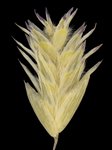
T. scintillans spikelet.
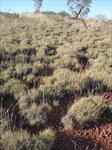
T. scintillans habitat.
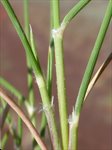
T. scintillans orifice and sheaths with sparkling droplets.
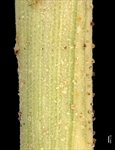
T. scintillans sheath, close-up of droplets.

T. scintillans leaf section.

T. scintillans lemmas.
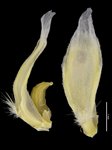
T. scintillans paleas.

T. scintillans map.
Name
Triodia scintillans B.M.Anderson & M.D.Barrett, ined.
Citation
Austral. Syst. Bot., in press, (2017)
Derivation
scintillans — from the Latin scintillo (to sparkle) in reference to the distinctive sparkly droplets on young material, especially noticeable in sunlight.Common name
Sparkling Spinifex
Synonyms
Triodia sp. Warrawagine (A.L. Payne PRP 1859)Diagnostic features
Hummocks small, 20–50 cm tall; foliage non-resinous; leaf sheath surfaces lacking hairs, young sheaths with minute sparkling colourless droplets; orifice hairs woolly; leaf blades 4–10(–13.7) cm long, amphistomatous (hard-type), usually green or dull green when fresh, but turning blue-green when stressed; inflorescences branched or unbranched with (1–)2–7 branches bearing more than one spikelet and 7–19 spikelets total; lower glume elliptic, 4–7.8 mm long, 8–14-nerved; lowest lemma lobed for about half its length, not awned, bitextured (indurated in the basal part, membranous in the upper part); midlobe of lowest lemma 2.8–5.2 mm long, lacking hairs; associated with ironstone mesas or gravelly slopes, or deep sand.
Habitat
Occurs typically associated with ironstone mesas or gravelly slopes, but plants in the north-east Pilbara on the edge of the Great Sandy Desert occur on deep sand at the base of dunes.
Distribution and frequency
Endemic to the north-east Pilbara and adjacent parts of Great Sandy Desert. Occurs in the eastern Chichester sub-region, and the adjacent western part of the Great Sandy Desert. Very common on ironstone plateaus from Cloudbreak Mine east to Balfour Downs, and scattered populations occur from there to the north-east as far as Nifty Mine.
Similar species
Triodia scintillans is a member of the Basedowii group, sharing the group features of non-resinous foliage, amphistomatous (hard-type) leaf blades and many-nerved (≥6) glumes.
Several other members of the Basedowii group occur in the Pilbara. Most plants of T. scintillans retain minute colourless droplets on the youngest sheath surfaces (sometimes also on the glumes and culms), a feature only otherwise found in T. vanleeuwenii amongst the Basedowii group species. Triodia scintillans and T. vanleeuwenii can be most effectively distinguished by distribution north (T. scintillans) and south (T. vanleeuwenii) of the Fortescue River, but they also differ in inflorescence features (with 7–19 spikelets, (1–)2–7 branches bearing more than one spikelet in T. scintillans, and with 5–9(–14) spikelets, 0–3(–5) branches bearing more than one spikelet in T. vanleeuwenii) and foliage colour in actively-growing plants (usually bright green in T. scintillans, usually dull blue in T. vanleeuwenii).
Older plants of T. scintillans lacking droplets on the sheaths can be distinguished from other members of the Basedowii group using other characters. Triodia infesta, T. mallota and T. plurinervata have unbranched panicles and spikelets with very short pedicles <3 mm long (longest basal pedicels >4 mm long in T. scintillans). The remaining Basedowii group species all have either branched inflorescences or longest basal pedicels more than 3 mm long.
Triodia basedowii, T. birriliburu, T. glabra and T. lanigera all have the longest leaves usually >15 cm long (<14 cm long in T. scintillans).
T. chichesterensis also has short leaves like T. scintillans, but a hairy lower half of the lemma midlobe (lacking hairs in T. scintillans) and lowest lemma midlobe generally longer (4.2–8 mm long in T. chichesterensis, 2.8–5.2 mm long in T. scintillans).
Triodia basedowii grows alongside T. scintillans at some locations, without any evidence of hybridization; T. scintillans can then be most easily distinguished by the shorter leaf blades (<14 cm) that lack hairs at their base (longest leaf blades usually >15 cm long and with the orifice hairs spreading onto the base of the leaf blades in T. basedowii).
Triodia brizoides of the Angusta-Wiseana group occurs in the same area and has similar leaf length and orifice hairs to T. scintillans. Triodia brizoides has 3–5(–9)-nerved lemmas (8–14-nerved in T. scintillans), and lemmas indurated over their whole length (lemmas distinctly bitextured with indurated lower part and membranous upper part in T. scintillans).
Conservation status
Not considered at risk.
Identification without florets
The features outlined above are sufficient to distinguish plants lacking florets. The distribution of T. scintillans does not overlap any species other than T. basedowii which has generally longer leaf blades (longest leaves usually >15 cm long, <14 cm long in T. scintillans); however T. chichesterensis and T. lanigera approach the distribution of T. scintillans.
Variation
The features outlined above are sufficient to distinguish plants lacking florets. The distribution of T. scintillans does not overlap any species other than T. basedowii which has generally longer leaf blades (longest leaves usually >15 cm long, <14 cm long in T. scintillans); however T. chichesterensis and T. lanigera approach the distribution of T. scintillans.
Notes
Triodia scintillans was treated under a broad concept of T. basedowii by Lazarides (1997), Lazarides et al. (2005) and Ausgrass (Sharp & Simon, 2002; Simon & Alonso, 2014).
A full description of T. scintillans can be found in Anderson et al. (2017a).
Grows intermixed with T. basedowii in sand swales at Nifty Mine in the Great Sandy Desert, without any evidence of hybridization (Anderson 2017b).